 Demon Daughter (Penric and Desdemona #12) by Lois McMaster Bujold
Demon Daughter (Penric and Desdemona #12) by Lois McMaster Bujold Format: ebook
Source: purchased from Amazon
Formats available: ebook
Genres: epic fantasy, fantasy
Series: Penric and Desdemona #12
Pages: 153
Published by Spectrum Literary Agency on January 9, 2024
Purchasing Info: Author's Website, Publisher's Website, Amazon, Barnes & Noble, Kobo
Goodreads
A six-year-old shiplost girl draws the kin Jurald family of Vilnoc into complex dilemmas, and sorcerer Learned Penric and his Temple demon Desdemona into conflict—with each other. It will take all of Penric’s wits, his wife Nikys’s wisdom, and the hand of the fifth god’s strangest saint to untangle the threads of their future.
My Review:
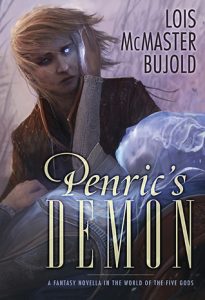 Demon Daughter – not Demon’s Daughter because that would be a different genre altogether – is a delightfully cozy entry in the Penric and Desdemona series.
Demon Daughter – not Demon’s Daughter because that would be a different genre altogether – is a delightfully cozy entry in the Penric and Desdemona series.
Not that there isn’t plenty of chaos along the way – because the god that Learned Penric kin Jurald serves as both sorcerer and Divine IS chaos. Or at least the god thereof. Penric serves the Fifth God, the Lord Bastard, the “master of all disasters out of season”. His god is also called the “White God” which, now that I’m thinking about it, makes him a sort of kin to the “White Rat” god in T. Kingfisher’s Saint of Steel series. Which actually works if you think about it a bit.
I digress.
For a series consisting entirely of novellas, Penric and Desdemona’s adventures are not only compelling, but they always leave me thinking more than expected. Because this is a world where the gods absolutely are manifest in people’s lives – not just by faith, but by having real influence on and actions in the world. (Also they explicitly come to their own people’s funerals, sometimes even in person, to take them ‘home’.)
Penric has spoken directly with his god, not just in the sense of prayers and imprecations, but as a real conversation. Although usually when his god is talking to him it means that Penric’s life is about to have more than the usual amount of chaos thrown into it. Again.
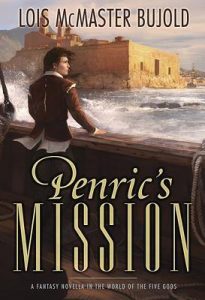 Which is exactly what happens in Demon Daughter, in a roundabout sort of way. The chaos at least.
Which is exactly what happens in Demon Daughter, in a roundabout sort of way. The chaos at least.
A little girl aboard her father’s ship pets a literal white rat (see, that connection isn’t quite so obscure after all) and starts setting things on fire. Aboard a wooden ship, that’s a recipe for death, disaster and oh yes and very much, chaos.
In a contest between little Otta and the entire crew of the merchant vessel, well, there’s not even a contest – even though the ship’s owner and captain is her own father. Otta gets thrown overboard while the crew sets to work putting out the fires, plural, lest they all end up joining her in the drink.
She washes ashore not far from Penric’s home in Vilnoc, gets scared, sets off more fires, and this time gets put in the bottom of a dry well while the local priest calls for somebody, anybody, from the Bastard’s Order to deal with this mess – because it most definitely is the Bastard’s business. Which gets Penric, his wife Nikys, and his demon Desdemona setting out for the tiny coastal village.
They take the little girl home and into their hearts. All of their hearts, including the demon Desdemona’s – in spite of Desdemona not having an actual heart or even a body of her own. Which becomes the real conflict within Penric.
His family wants to adopt the little girl as their own. Desdemona wants to adopt the little girl’s little demon as her own. But Penric answers to the White God, and he may have other plans, that may very well hinge on which choice adds the most chaos to Penric’s already chaotic life.
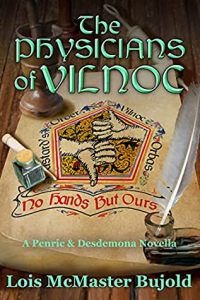 Escape Rating A: This twelfth entry in the Penric and Desdemona series could almost be classed as a ‘cozy fantasy’. Even with all the chaos naturally generated by Penric’s service to the Lord Bastard, this particular story is very home-oriented and relationship-centric in a way that is just warm and, well, cozy, because Penric’s household is both of those things – even in the depths of winter while he’s teaching a young girl and her even younger demon the art of NOT setting everything on fire.
Escape Rating A: This twelfth entry in the Penric and Desdemona series could almost be classed as a ‘cozy fantasy’. Even with all the chaos naturally generated by Penric’s service to the Lord Bastard, this particular story is very home-oriented and relationship-centric in a way that is just warm and, well, cozy, because Penric’s household is both of those things – even in the depths of winter while he’s teaching a young girl and her even younger demon the art of NOT setting everything on fire.
Which turns out to be all about making sure Otta is not anxious and afraid – not the easiest things to do for a child who has been literally thrown away from her home and family, is scared out of her wits that she might have accidentally killed everyone she loves, and is forced to deal with concepts and responsibilities that are well beyond her years.
Otta is an accidental sorceress, just as Penric became an equally accidental sorcerer twenty years ago, a story told in Penric’s Demon. But Penric was an adult, maybe just barely, but old enough to attend Seminary and learn the ropes of being a Temple Sorcerer and Learned Divine and all that went with it. AND more importantly, having enough experience to truly understand what he was learning. Most of it anyway.
His demon, Desdemona, was centuries old, very experienced, and was as much his teacher as any of his more corporeal tutors.
Otta is just six, her demon’s very first manifestation was that little white rat, and it only received a few days of experience at most. It can’t teach her and she can’t teach it – but Penric and Desdemona are perfect for that job. Jobs.
But Otta is just a little girl, just as Atto, her demon, is just a very little demon. It is Penric’s duty to train Otta enough that she stops setting fires. But she becomes part of the family, which is where all the conflicts and all the thoughts that raced through my head came in.
How does a small child cope when adult responsibilities are thrust upon them? More importantly, how does anyone cope when all of their teaching and training up to that point has indoctrinated them into believing that they have become an abomination – because the thing they are is something they have been taught doesn’t exist and should absolutely not be believed in?
Those are big questions, questions that little Otta has to wrestle with in a way that Penric never did. (His people did believe in the Fifth God, even if none of them ever expected to serve him directly. Otta’s people absolutely did NOT.) Those big questions and indoctrinated beliefs lead to choices that Otta and only Otta can make – all Penric and Desdemona can do is give them a strong foundation on which to stand while they make that choice.
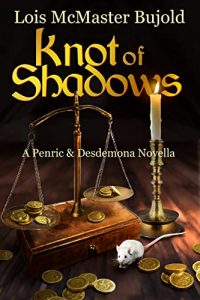 It’s those questions that stick in my mind after finishing Demon Daughter. Because there are entirely too many people in the real world who face that dilemma every day while trying to live their truth even though they’ve been taught by family, faith and community that their truth is a lie.
It’s those questions that stick in my mind after finishing Demon Daughter. Because there are entirely too many people in the real world who face that dilemma every day while trying to live their truth even though they’ve been taught by family, faith and community that their truth is a lie.
In Otta’s case it’s easy to see the solution – even as we feel how difficult it is for a little girl to turn away from everything she’s known and form a new path for herself and the little demon she has become responsible for. In the real world, it’s not nearly so easy, both because Otta has a good, firm support network in Penric, Desdemona, and their family, and because the reality of her god is, well, real in a way that can erase many doubts. But her being forced to decide whether to break with her birth family or give up the thing that makes her whole breaks my heart even more than Otta’s decision nearly broke Penric’s, Desdemona’s, and even Otta’s own.
Now that Otta has become part of Penric’s household, it will be fun to see how his and Des’ training of the little sorcerette (Otta is much too little to be even an apprentice sorceress – yet) works its way into the next bit of chaos that the Lord Bastard sends their way. I’m already looking forward to reading those adventures, whenever the chaos surrounding their deity allows them to appear!

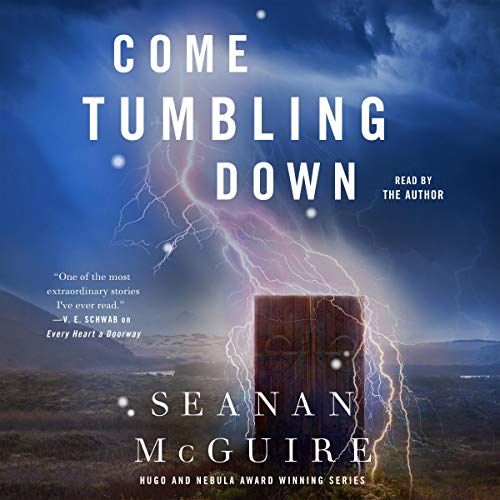 Come Tumbling Down (Wayward Children, #5) by
Come Tumbling Down (Wayward Children, #5) by 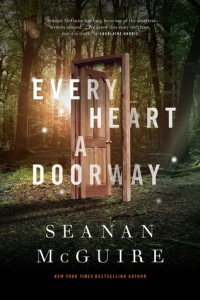 I’ve been winding my way through Seanan McGuire’s
I’ve been winding my way through Seanan McGuire’s 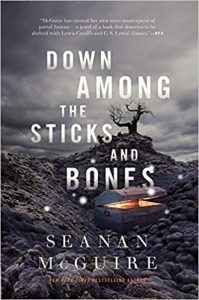 Jack is in dire straits when she returns to the school, and she needs the help of the only friends she can trust to see that, in spite of appearances, she’s still Jack even though she’s in her twin sister Jill’s body. They are the only people who know her well enough to understand that her OCD will not allow her to just adapt to living her life in the unclean thing that murdered her mentor – even if Jill’s full, entire, complete and utterly nefarious plot is to destroy both her sister Jack and the balance that keeps The Moors relatively safe and functional for the human population that was born to a world where vampires contend with mad scientists and drowned gods prey upon ships and shorelines, where the sun only rises behind thick clouds and lightning storms happen whenever the Moon wills it so.
Jack is in dire straits when she returns to the school, and she needs the help of the only friends she can trust to see that, in spite of appearances, she’s still Jack even though she’s in her twin sister Jill’s body. They are the only people who know her well enough to understand that her OCD will not allow her to just adapt to living her life in the unclean thing that murdered her mentor – even if Jill’s full, entire, complete and utterly nefarious plot is to destroy both her sister Jack and the balance that keeps The Moors relatively safe and functional for the human population that was born to a world where vampires contend with mad scientists and drowned gods prey upon ships and shorelines, where the sun only rises behind thick clouds and lightning storms happen whenever the Moon wills it so. Escape Rating A-: The
Escape Rating A-: The 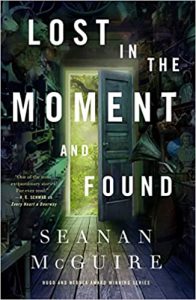 One of the core tenets of the whole, entire,
One of the core tenets of the whole, entire, 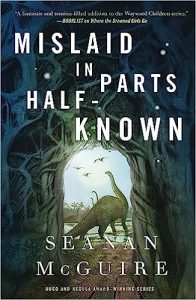 So, on the surface there’s a story about vampires and mad scientists set in a place that the great horror movies might have used for their inspiration – if not their actual setting. Underneath that there’s a deeper story about balances of power and how devastating it can be when those balances become unbalanced. And the story of one heroine who is willing to throw her own body into the breach – along with her sister’s corpse – to preserve that balance at truly any and every cost.
So, on the surface there’s a story about vampires and mad scientists set in a place that the great horror movies might have used for their inspiration – if not their actual setting. Underneath that there’s a deeper story about balances of power and how devastating it can be when those balances become unbalanced. And the story of one heroine who is willing to throw her own body into the breach – along with her sister’s corpse – to preserve that balance at truly any and every cost.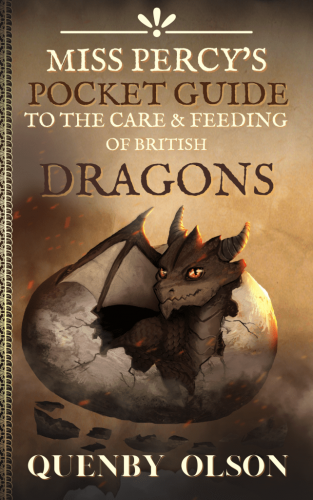 Miss Percy's Pocket Guide to the Care and Feeding of British Dragons (Miss Percy Guide, #1) by
Miss Percy's Pocket Guide to the Care and Feeding of British Dragons (Miss Percy Guide, #1) by 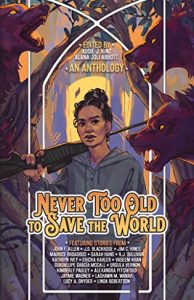 Escape Rating A-: I picked this up because I saw it on a list of cozy fantasies, and it seemed like the perfect book for a chilly winter weekend. And it was calling my name rather loudly, with occasional puffs of smoke for emphasis.
Escape Rating A-: I picked this up because I saw it on a list of cozy fantasies, and it seemed like the perfect book for a chilly winter weekend. And it was calling my name rather loudly, with occasional puffs of smoke for emphasis.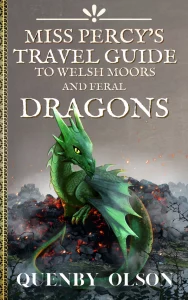 I got so deeply into the story that it took me halfway through before the dragon’s name dropped the clue-by-four on my head – just as the villains attempted to throw the creature from a second-story window. (The dragon has wings, so things did not go AT ALL according to their dastardly plan.) They named the dragon Fitz, after, of course, Fitzwilliam Darcy. Making the ‘pocket’ description of Miss Percy’s Pocket Guide to the Care & Feeding of British Dragons – you guessed it and I’m chagrined at how long it took me to – Pride and Prejudice and Dragons!
I got so deeply into the story that it took me halfway through before the dragon’s name dropped the clue-by-four on my head – just as the villains attempted to throw the creature from a second-story window. (The dragon has wings, so things did not go AT ALL according to their dastardly plan.) They named the dragon Fitz, after, of course, Fitzwilliam Darcy. Making the ‘pocket’ description of Miss Percy’s Pocket Guide to the Care & Feeding of British Dragons – you guessed it and I’m chagrined at how long it took me to – Pride and Prejudice and Dragons!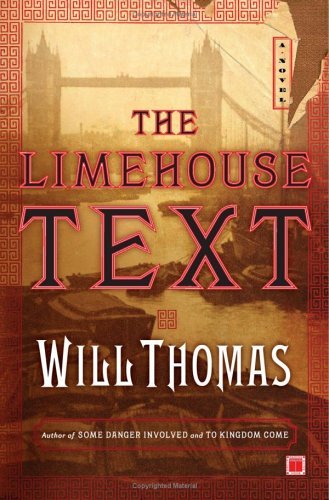 The Limehouse Text (Barker & Llewelyn, #3) by
The Limehouse Text (Barker & Llewelyn, #3) by 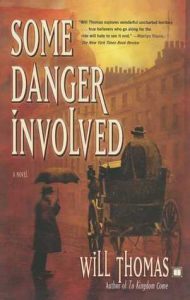 I was feeling in a bit of a murder-y mood this week – reading-wise at least. Which seems entirely fitting as we’re ‘killing’ 2023 this weekend and ringing in 2024.
I was feeling in a bit of a murder-y mood this week – reading-wise at least. Which seems entirely fitting as we’re ‘killing’ 2023 this weekend and ringing in 2024. 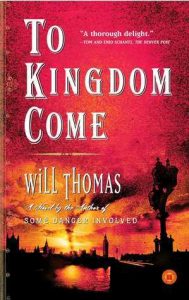 Escape Rating A+: One thing drove me utterly bananas during my reading of The Limehouse Text. I had the vague impression, not that I’d read this before, but that the Jeremy Brett Sherlock Holmes series had also tackled a story set in Limehouse – London’s Victorian version of Chinatown – but couldn’t track down precisely which story. I think it may have been
Escape Rating A+: One thing drove me utterly bananas during my reading of The Limehouse Text. I had the vague impression, not that I’d read this before, but that the Jeremy Brett Sherlock Holmes series had also tackled a story set in Limehouse – London’s Victorian version of Chinatown – but couldn’t track down precisely which story. I think it may have been 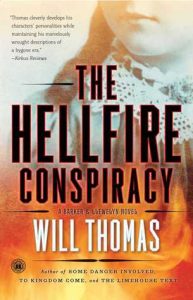 In the end, this is a clever, convoluted mystery, solved but not truly resolved by fascinating characters, steeped in a culture and a perspective that was not treated with any kind of respect in its time and about which stereotypes promoted during this period still linger. The reader is inexorably drawn in by the mystery and the setting, and left with both the satisfaction of at least some just desserts being served – as a mystery should – while still reeling from the marvelously presented microcosm of all the reasons why ‘colonialism’ is such a disgustingly dirty word in so many places around the globe to this very day.
In the end, this is a clever, convoluted mystery, solved but not truly resolved by fascinating characters, steeped in a culture and a perspective that was not treated with any kind of respect in its time and about which stereotypes promoted during this period still linger. The reader is inexorably drawn in by the mystery and the setting, and left with both the satisfaction of at least some just desserts being served – as a mystery should – while still reeling from the marvelously presented microcosm of all the reasons why ‘colonialism’ is such a disgustingly dirty word in so many places around the globe to this very day.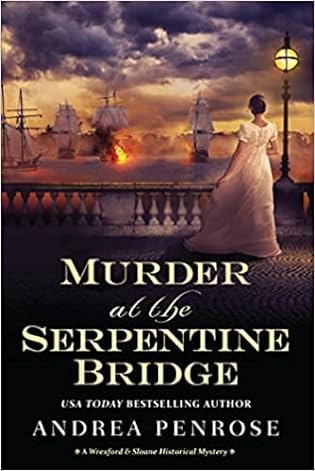 Murder at the Serpentine Bridge (Wrexford & Sloane, #6) by
Murder at the Serpentine Bridge (Wrexford & Sloane, #6) by  As the previous book in this series,
As the previous book in this series, 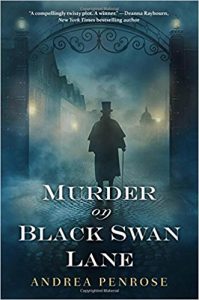 Escape Rating A: This was the right book at the right time, and I clearly waited enough time after
Escape Rating A: This was the right book at the right time, and I clearly waited enough time after  Meanwhile, everyone is chasing everyone else’s tails into danger, as the government’s intelligence services are unwilling to let the right hand know what the left hand is doing (shades of yesterday’s book) and everyone is unwittingly keeping vital clues from even their nearest and dearest.
Meanwhile, everyone is chasing everyone else’s tails into danger, as the government’s intelligence services are unwilling to let the right hand know what the left hand is doing (shades of yesterday’s book) and everyone is unwittingly keeping vital clues from even their nearest and dearest.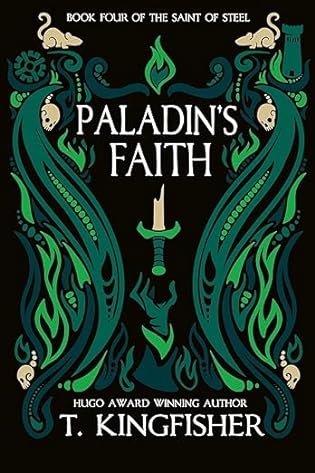 Paladin's Faith (The Saint of Steel, #4) by
Paladin's Faith (The Saint of Steel, #4) by 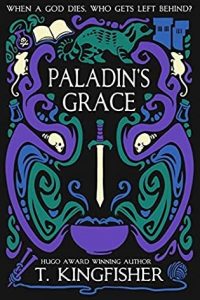 There’s a classic saying about large organizations at cross-purposes within themselves, that the right-hand doesn’t know what the left hand is doing. Marguerite Florian’s problem with the Red Sail mercantile empire is that their “right hand does not know who the left is killing”.
There’s a classic saying about large organizations at cross-purposes within themselves, that the right-hand doesn’t know what the left hand is doing. Marguerite Florian’s problem with the Red Sail mercantile empire is that their “right hand does not know who the left is killing”.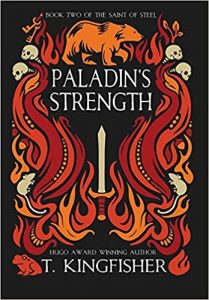 Marguerite just has to stay alive long enough to find the artificer. For that, she’ll need bodyguards who can’t be bribed or bought, seduced or suborned. She needs a paladin – or two.
Marguerite just has to stay alive long enough to find the artificer. For that, she’ll need bodyguards who can’t be bribed or bought, seduced or suborned. She needs a paladin – or two.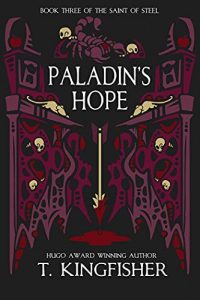 Howsomever, by the nature of that waiting game a LOT of this story is extremely interesting character development with a fair bit of adding to the depth of the worldbuilding but one does, like one of the side characters, Davith, want them to just ‘get on with it’ one way or another, either to get a move on in their mission or just make a move on each other.
Howsomever, by the nature of that waiting game a LOT of this story is extremely interesting character development with a fair bit of adding to the depth of the worldbuilding but one does, like one of the side characters, Davith, want them to just ‘get on with it’ one way or another, either to get a move on in their mission or just make a move on each other.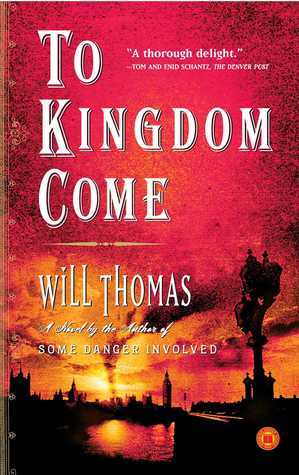 To Kingdom Come (Barker & Llewelyn, #2) by
To Kingdom Come (Barker & Llewelyn, #2) by 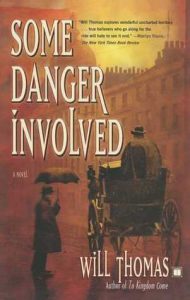 After the events of the first marvelous book in this series,
After the events of the first marvelous book in this series, 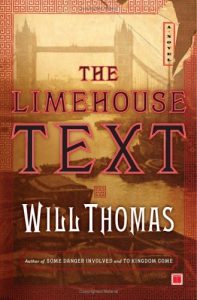 What kept me glued to my seat (as this turned out to be a one-sitting/one-evening read) was the way that it dove head-first both into the heart of its point-of-view character Thomas Llewelyn and into the hearts and motivations of the Irish Republican Brotherhood faction members, and the difficulty that Llewelyn had separating himself from them and his sympathy for their cause even as he decried their methods and worked to bring them down, doing his best to keep them all from being blown “to kingdom come”.
What kept me glued to my seat (as this turned out to be a one-sitting/one-evening read) was the way that it dove head-first both into the heart of its point-of-view character Thomas Llewelyn and into the hearts and motivations of the Irish Republican Brotherhood faction members, and the difficulty that Llewelyn had separating himself from them and his sympathy for their cause even as he decried their methods and worked to bring them down, doing his best to keep them all from being blown “to kingdom come”.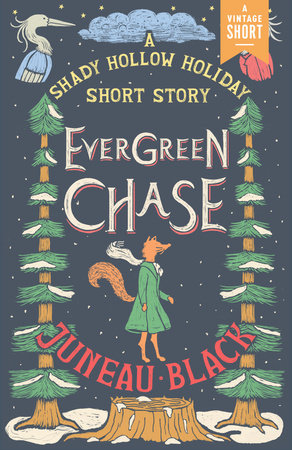 Evergreen Chase: A Shady Hollow Mystery Short Story by
Evergreen Chase: A Shady Hollow Mystery Short Story by 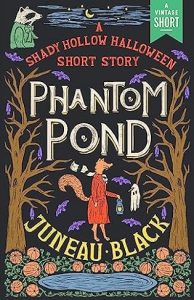 This is explicitly not a Christmas story, just as
This is explicitly not a Christmas story, just as  That the town pulls together to celebrate the solstice with or without the tree is all part of the series’ charm. That they have their own solstice miracle just adds to the sweetness of both the story and the holiday season – both theirs and ours.
That the town pulls together to celebrate the solstice with or without the tree is all part of the series’ charm. That they have their own solstice miracle just adds to the sweetness of both the story and the holiday season – both theirs and ours.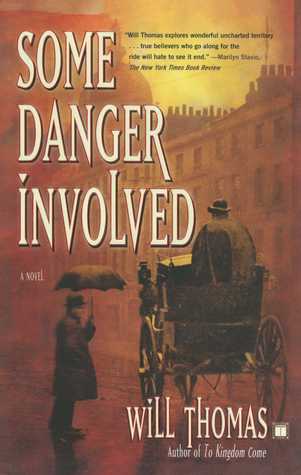 Some Danger Involved (Barker & Llewelyn, #1) by
Some Danger Involved (Barker & Llewelyn, #1) by  Murder at the Royal Botanic Gardens (Wrexford & Sloane, #5) by
Murder at the Royal Botanic Gardens (Wrexford & Sloane, #5) by 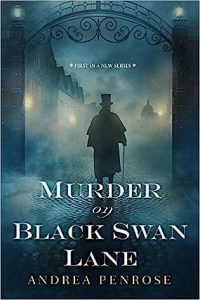 This fifth book in the
This fifth book in the  Before Charlotte can be truly happy, all of those swords hanging over her head have to be carefully taken down, while she and Wrexford are in the midst of solving a criminal conspiracy that turns out to have more heads than Hydra. That the sheer tangle of threats coming their way makes both of them realize just how many hostages to fortune they have gathered around themselves over the course of their investigations adds to Charlotte’s worry and angst.
Before Charlotte can be truly happy, all of those swords hanging over her head have to be carefully taken down, while she and Wrexford are in the midst of solving a criminal conspiracy that turns out to have more heads than Hydra. That the sheer tangle of threats coming their way makes both of them realize just how many hostages to fortune they have gathered around themselves over the course of their investigations adds to Charlotte’s worry and angst.